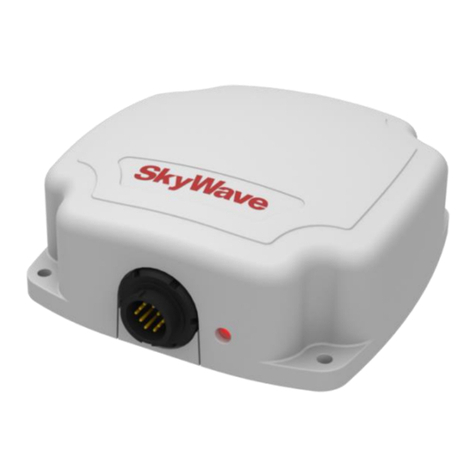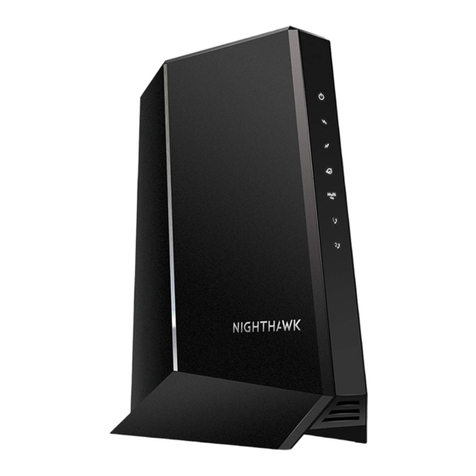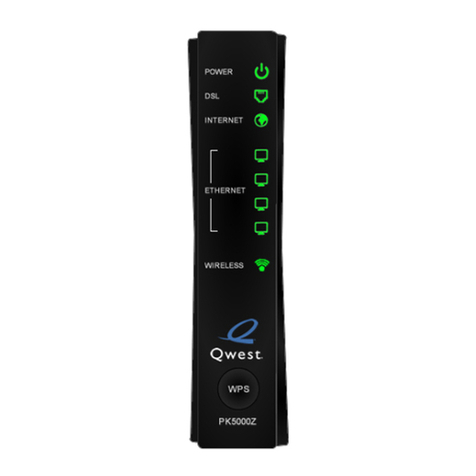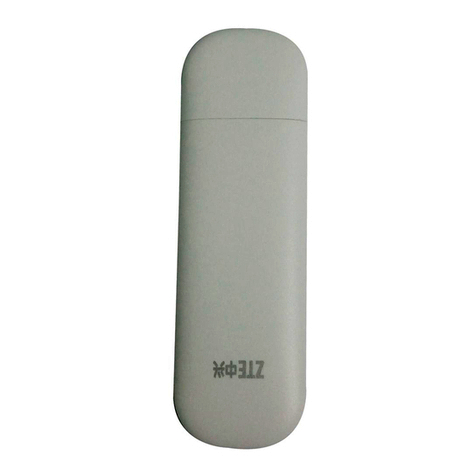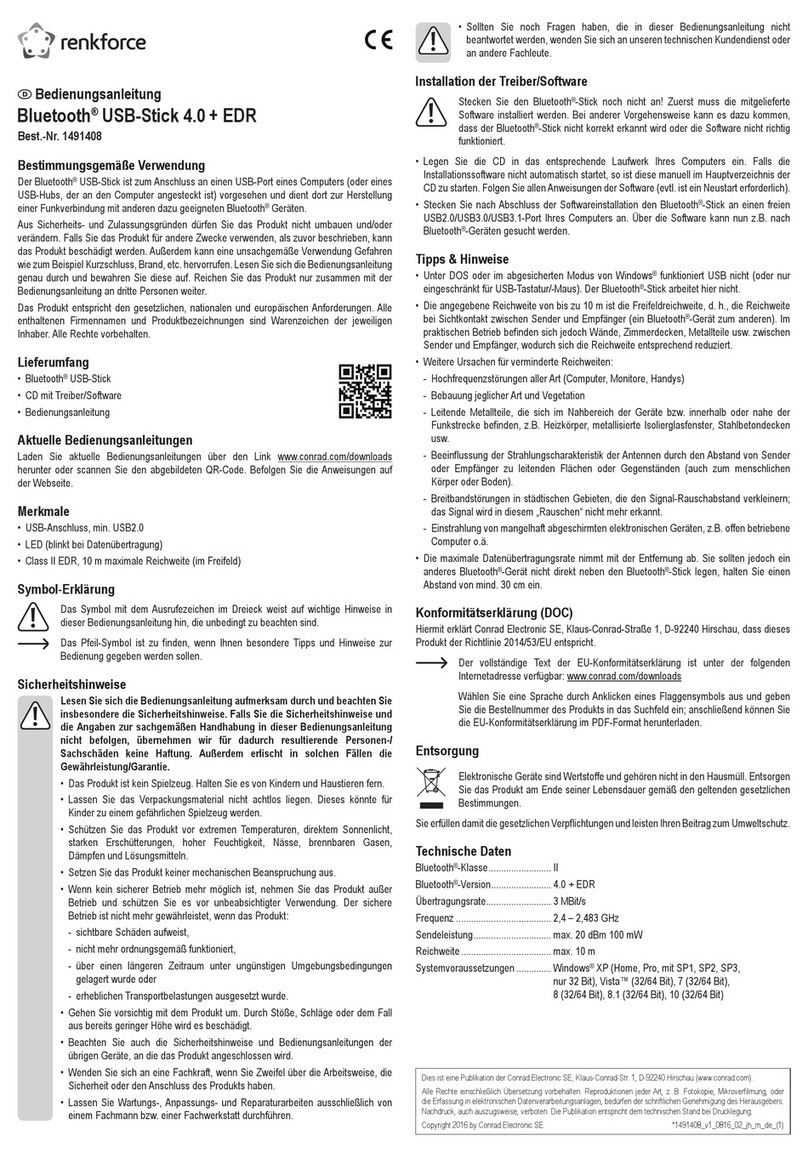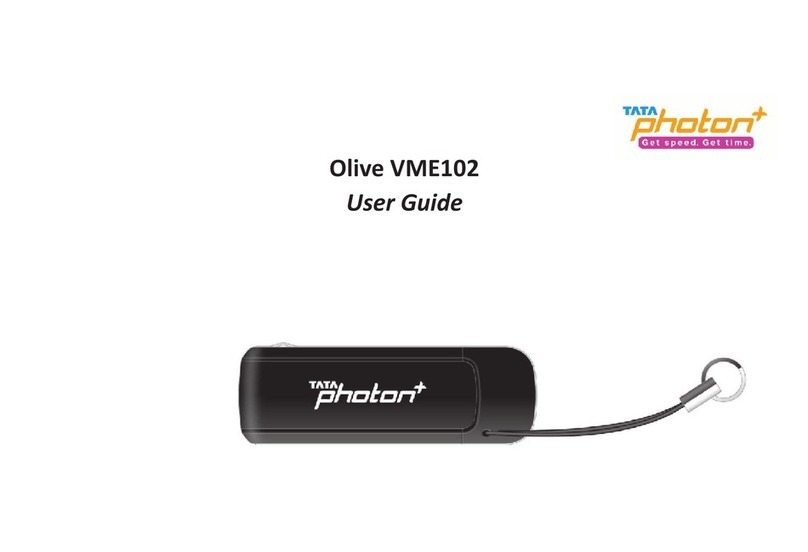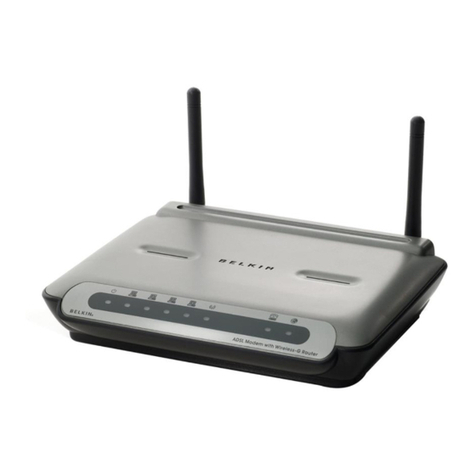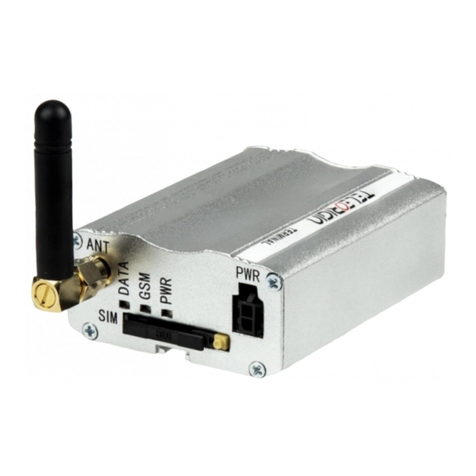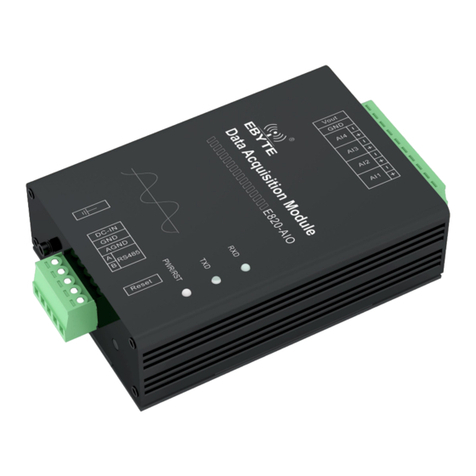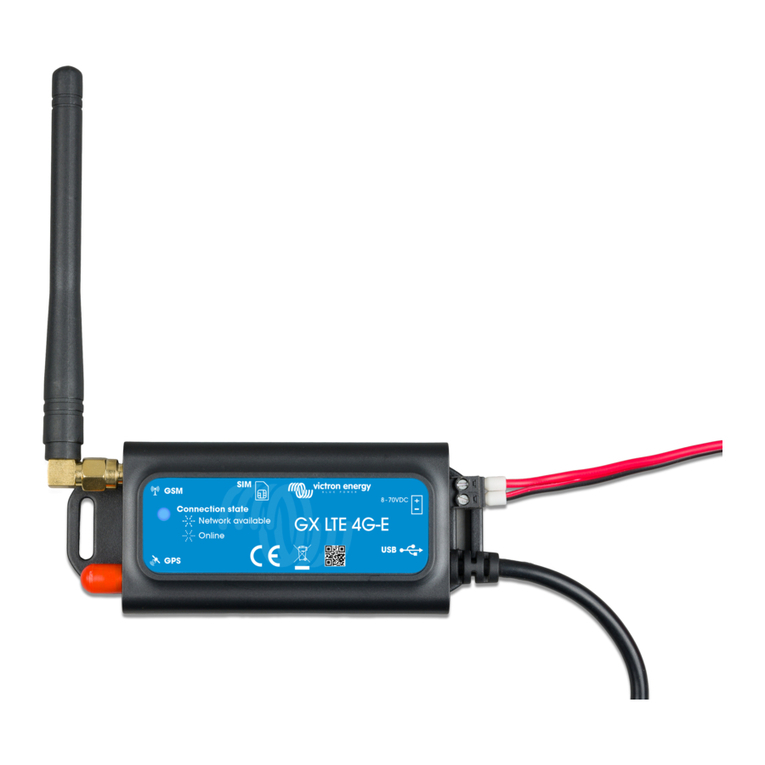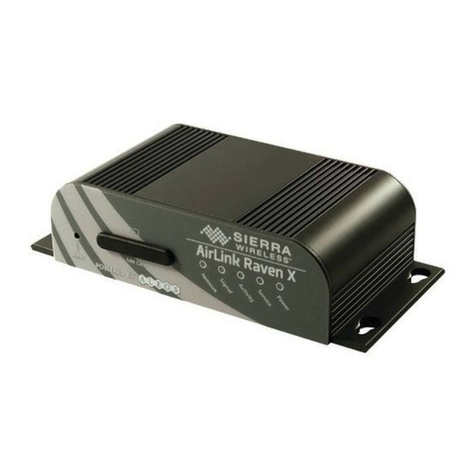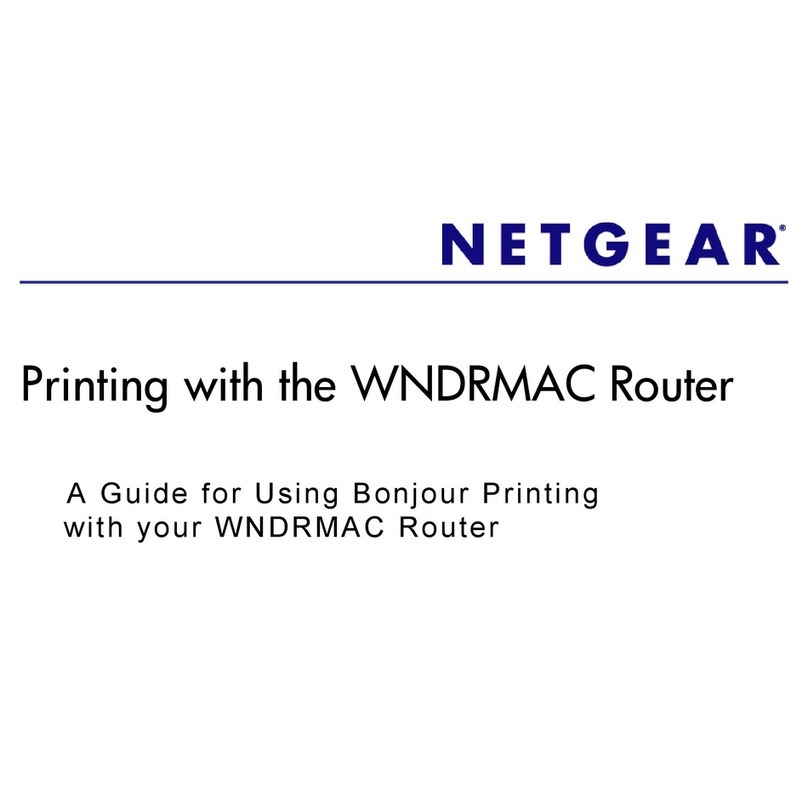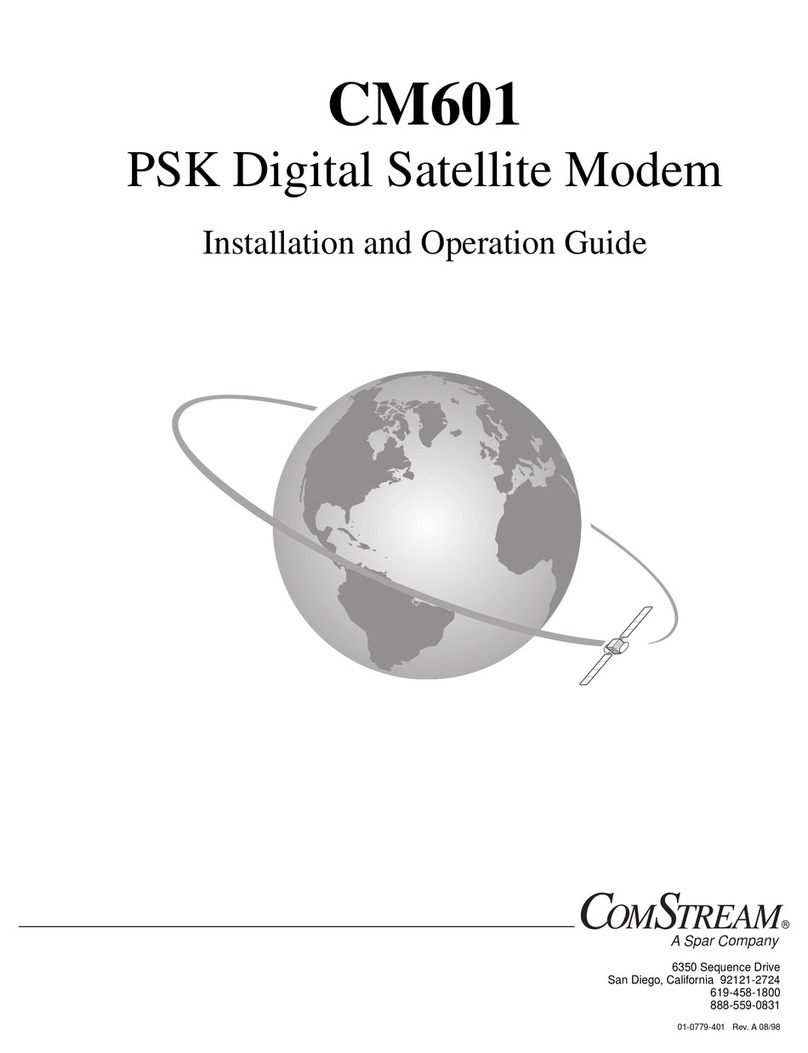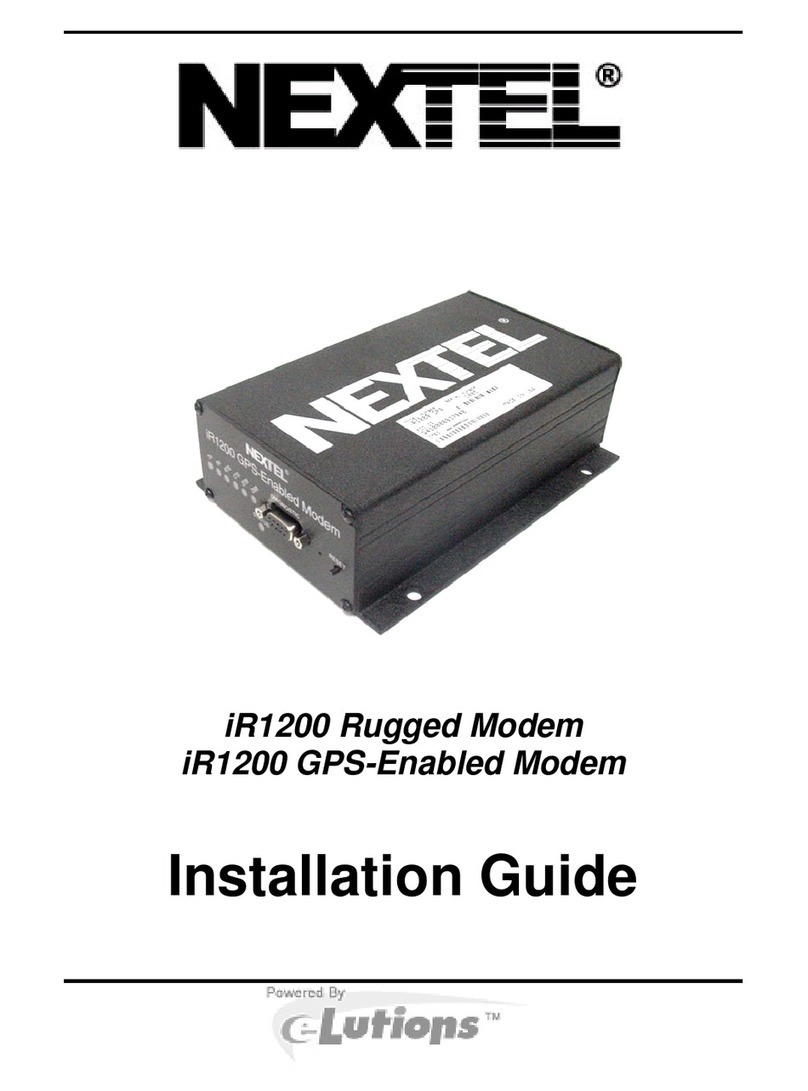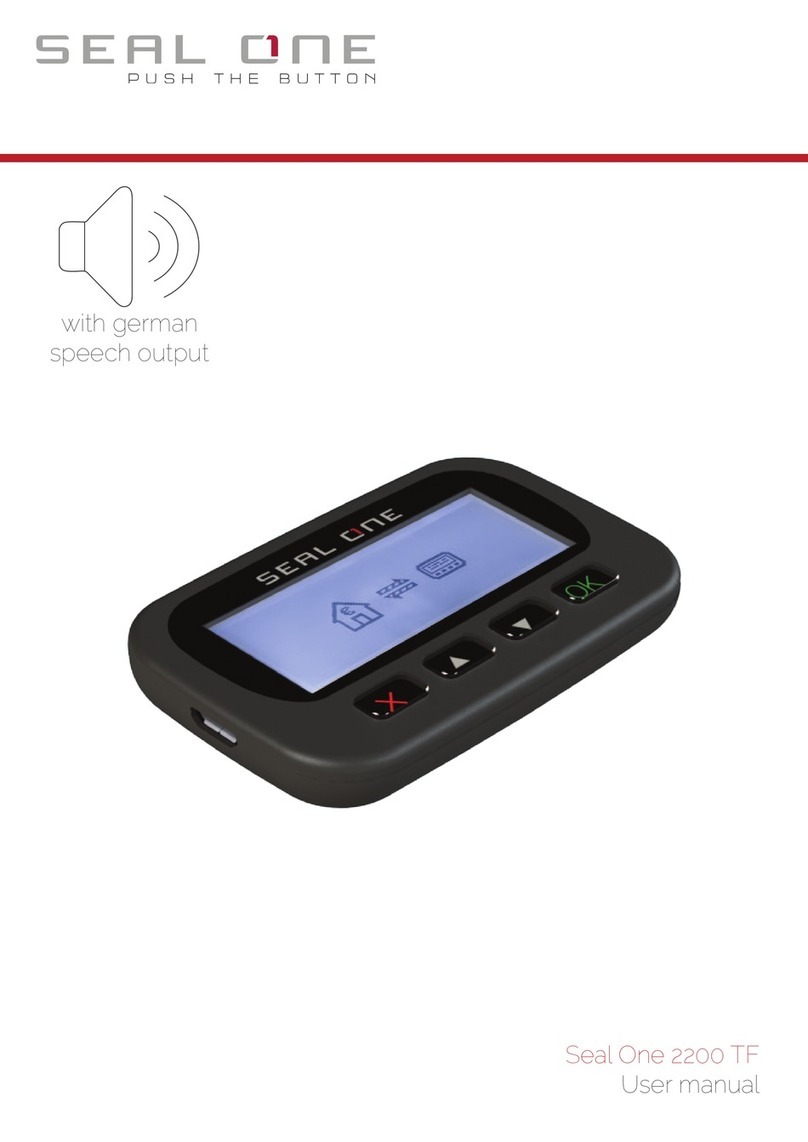SkyWave IDP 100 Series Instruction Manual

IDP 100 Modem Series
Developer Guide
T203, Version 04
The electronic version of this document allows
you to use the built-in Hyperlinks and
bookmarks when using Adobe Reader
© SkyWave Mobile Communications Inc.

IDP 100 Modem Series - Developer Guide
T203, Version 04 ii © SkyWave Proprietary
Legal Notice
This documentation is owned by SkyWave Mobile Communications Inc. (SkyWave) and protected by
applicable copyright laws and international treaty provisions. Other copyrighted names used are the property
of their respective owners. Therefore, you must treat this documentation like any other copyrighted material.
You may not make the documentation, or copies thereof, available in any manner or form, or use, copy or
transfer any part, to anyone outside your company.
If you received this documentation by electronic transmission or download, by installation or use of the
documentation, you acknowledge that you have read and understand this license agreement and agree to be
bound by its terms and conditions.
This documentation is provided on an as-is basis without any warranty of any kind. You assume the entire
risk as to the results or performance of the software. Under no circumstance shall SkyWave be held liable for
any direct, indirect, consequential, or incidental damages arising from the use or inability to use the software
or documentation.
All trademarks or registered trademarks are the property of their respective owners. INMARSAT, the
Inmarsat logo and IsatData Pro are trademarks of Inmarsat used under license by SkyWave. Inmarsat is not
responsible for the operation and regulatory compliance of the products and services referred to in this
document that connect to the Inmarsat system.
SkyWave reserves the right to make changes to products and or specifications without notice.
From www.SkyWave.com login, and follow the link to the downloads section. The complete Software and
Documentation License Agreement is distributed as a part of the IDP Developer Toolkit.
Contact Information
SkyWave Mobile Communications Inc.
Online:
Website www.SkyWave.com
Online Documentation:
Login at support.skywave.com and follow the link to the downloads section
Customer Support by Email:
support@skywave.com
Customer Support by Telephone:
+1.613.836.2222

IDP 100 Modem Series - Developer Guide
© SkyWave Proprietary iii T203, Version 04
TABLE OF CONTENTS
Legal Notice....................................................................................................................................ii
Contact Information......................................................................................................................ii
List of Figures..............................................................................................................................vii
List of Tables................................................................................................................................ vii
Preface........................................................................................................................................... ix
What's New?................................................................................................................................ ix
Purpose ........................................................................................................................................ ix
Audience...................................................................................................................................... ix
Notation ....................................................................................................................................... ix
Reference...................................................................................................................................... x
Limited Liability........................................................................................................................... x
1Introduction......................................................................................................................... 1
2Modem Overview................................................................................................................ 3
2.1 Satellite Operation.............................................................................................................. 3
2.1.1 Traffic Channel Acquisition ......................................................................................... 3
2.1.2 Acquisition Times......................................................................................................... 3
2.1.3 Modem Registration Message ...................................................................................... 3
2.1.4 Beam Switch................................................................................................................. 3
2.1.5 Blockage ....................................................................................................................... 4
2.1.6 Muting........................................................................................................................... 4
2.2 Message States ................................................................................................................... 4
2.2.1 To-Mobile States........................................................................................................... 5
2.2.2 From-Mobile States ...................................................................................................... 6
2.3 AT Message Commands .................................................................................................... 7
2.3.1 From-Mobile Messages ................................................................................................ 7
2.3.2 To-Mobile Messages..................................................................................................... 8
2.4 On-board Memory.............................................................................................................. 9
2.4.1 Satellite Messages....................................................................................................... 10
2.4.2 Network Configuration............................................................................................... 11
2.4.3 S Registers.................................................................................................................. 11
2.5 Trace Table....................................................................................................................... 11
2.6 Modem Outputs................................................................................................................ 11
2.6.1 Reset Out .................................................................................................................... 12
2.6.2 Event Notification....................................................................................................... 12
2.7 GPS................................................................................................................................... 12
2.7.1 GPS Request Sources.................................................................................................. 12
2.7.2 GPS Fix Type ............................................................................................................. 13
2.7.3 GPS Fix Times............................................................................................................ 13
2.7.4 Satellite Transmit Effects............................................................................................ 14
2.8 Broadcast Messages ......................................................................................................... 14
3Over-the-Air Interface...................................................................................................... 15
3.1 Message Lengths.............................................................................................................. 15
3.2 Message Types................................................................................................................. 15
3.2.1 Modem Messages ....................................................................................................... 15

IDP 100 Modem Series - Developer Guide
T203, Version 04 iv © SkyWave Proprietary
3.2.2 Terminal Core Services .............................................................................................. 16
3.2.3 User Services.............................................................................................................. 16
4Serial Modes...................................................................................................................... 17
4.1 Mode Switches................................................................................................................. 17
4.1.1 Baud Rate.................................................................................................................... 17
5AT Command Mode......................................................................................................... 19
5.1 Syntax Definition ............................................................................................................. 19
5.1.1 Conventions................................................................................................................ 19
5.1.2 Command Rules.......................................................................................................... 19
5.1.3 AT Command General Format ................................................................................... 19
5.2 Transfer Mode.................................................................................................................. 23
5.3 Basic Command Set ......................................................................................................... 23
5.3.1 E –Echo...................................................................................................................... 23
5.3.2 I –Request ID............................................................................................................. 24
5.3.3 Q –Quiet..................................................................................................................... 24
5.3.4 V –Verbose................................................................................................................ 24
5.3.5 Z –Load Saved Values............................................................................................... 24
5.3.6 &F –Load with Factory Default Values..................................................................... 24
5.3.7 &V –Display Configurations..................................................................................... 25
5.3.8 &W –Save Configuration .......................................................................................... 25
5.3.9 Null Command............................................................................................................ 25
5.3.10 A/ –Repeat Last Command........................................................................................ 25
5.4 S Register Commands ...................................................................................................... 26
5.4.1 Command Format....................................................................................................... 26
5.4.2 S Register Types......................................................................................................... 26
5.4.3 S Register Definitions................................................................................................. 26
5.4.4 S3 –Command Line Terminator ................................................................................ 28
5.4.5 S4 –Response Formatting Character.......................................................................... 29
5.4.6 S5 –Command Line Editing Character...................................................................... 29
5.4.7 S50 –Power Mode...................................................................................................... 30
5.4.8 S51 –Wake-up Interval.............................................................................................. 30
5.4.9 S60 –Echo Setting (S60)............................................................................................ 31
5.4.10 S61 –Quiet Setting..................................................................................................... 31
5.4.11 S62 –Verbose Setting................................................................................................. 32
5.4.12 S63 –CRC Setting...................................................................................................... 32
5.4.13 S64 –Prefix Character of CRC Sequence .................................................................. 33
5.4.14 S80 –Last Error Code ................................................................................................ 33
5.4.15 S81 –Most Recent Result Code ................................................................................. 34
5.4.16 S85 –Internal Temperature ........................................................................................ 34
5.4.17 S88 –Event Notification Control ............................................................................... 35
5.4.18 S89 –Event Notification Assert Status....................................................................... 36
5.4.19 S90, S91, S92 –Capture Trace Define....................................................................... 37
5.4.20 S93 –Captured Record Properties - Length............................................................... 38
5.4.21 S94 –Captured Record Properties - Data Sign........................................................... 38
5.4.22 S95 –Captured Record Properties - Network ID ....................................................... 39
5.4.23 S96 –Captured Record Properties - Timestamp......................................................... 39
5.4.24 S97, S98 –Captured Trace Properties - Class/Subclass............................................. 40
5.4.25 S99 –Captured Trace Properties - Severity Level...................................................... 40
5.4.26 S100, S101, …S123 – Captured Trace Data - Index.................................................. 41

IDP 100 Modem Series - Developer Guide
© SkyWave Proprietary v T203, Version 04
5.5 Extended Commands........................................................................................................ 42
5.6 SkyWave-Proprietary Extended Commands.................................................................... 43
5.6.1 %CRC –Error Detection............................................................................................ 44
5.6.2 %EVNT –Event Log Get........................................................................................... 45
5.6.3 %EXIT –Exit Command............................................................................................ 47
5.6.4 %GPS –Get GPS Information.................................................................................... 48
5.6.5 %MGFG –To-Mobile Message Get........................................................................... 49
5.6.6 %MGFM –To-Mobile Message Rx Retrieved .......................................................... 52
5.6.7 %MGFN –To-Mobile Message New......................................................................... 53
5.6.8 %MGFS –To-Mobile Message State......................................................................... 55
5.6.9 %MGRC –From-Mobile Message Cancel................................................................. 57
5.6.10 %MGRS –From-Mobile Message State .................................................................... 58
5.6.11 %MGRT –From-Mobile Message Send.................................................................... 60
5.6.12 %SREG –View all S Registers.................................................................................. 63
5.6.13 %UTC –Display UTC Date and Time....................................................................... 63
5.7 Error Result Codes ........................................................................................................... 64
6Trace Log Mode................................................................................................................ 65
6.1 Trace Log Mode Commands............................................................................................ 65
6.2 Trace Types...................................................................................................................... 65
6.3 AT Command Access....................................................................................................... 65
6.4 Trace Record Format........................................................................................................ 66
6.4.1 Trace Record Header.................................................................................................. 66
6.4.2 Class Data................................................................................................................... 67
6.5 Trace Class Definitions.................................................................................................... 68
6.5.1 System Reset Event Traces (Class 2).......................................................................... 68
6.5.2 Satellite Event Traces (Class 3).................................................................................. 70
6.5.3 GPS (Class 4).............................................................................................................. 76
6.5.4 Receive Message (Class 5)......................................................................................... 77
APPENDIX A Supported AT Commands.............................................................................. 79
APPENDIX B To-Mobile Messages........................................................................................ 80
B.1 reset (MIN 68).................................................................................................................. 80
B.2 setSleepSchedule (MIN 70).............................................................................................. 81
B.3 setTxMute (MIN 71) ........................................................................................................ 81
B.4 getPosition (MIN 72)........................................................................................................ 82
B.5 getConfiguration (MIN 97) .............................................................................................. 82
B.6 pingRequest (MIN 112).................................................................................................... 82
B.7 pingResponse (MIN 113)................................................................................................. 83
B.8 getBroadcastIDs (MIN 115)............................................................................................. 83
APPENDIX C From-Mobile Messages................................................................................... 84
C.1 modemRegistration (MIN 0)............................................................................................ 84
C.2 protocolError (MIN 2)...................................................................................................... 85
C.3 sleepSchedule (MIN 70)................................................................................................... 86
C.4 position (MIN 72)............................................................................................................. 87
C.5 configuration (MIN 97).................................................................................................... 87
C.6 pingResponse (MIN 112)................................................................................................. 88
C.7 pingRequest (MIN 113).................................................................................................... 88
C.8 testMessage (MIN 114).................................................................................................... 89
C.9 broadcastIDs (MIN 115) .................................................................................................. 89

IDP 100 Modem Series - Developer Guide
T203, Version 04 vi © SkyWave Proprietary
Documentation Version............................................................................................................... 91
Acronyms/Glossary..................................................................................................................... 92
Index… ......................................................................................................................................... 93

IDP 100 Modem Series - Developer Guide
© SkyWave Proprietary vii T203, Version 04
List of Figures
Figure 1 Beam Switch................................................................................................................. 4
Figure 2 Message States.............................................................................................................. 5
Figure 3 From-Mobile AT Command Parameters...................................................................... 7
Figure 4 Priority Messages.......................................................................................................... 8
Figure 5 To-Mobile Message AT Command Parameters ........................................................... 9
Figure 6 Message Partitions...................................................................................................... 10
Figure 7 Modem General Purpose Outputs............................................................................... 12
Figure 8 Trace Log.................................................................................................................... 65
Figure 9 Trace Record Format.................................................................................................. 66
List of Tables
Table 1 Maximum Flash Size.................................................................................................. 10
Table 2 Configurable Conditions............................................................................................. 12
Table 3 Message Lengths......................................................................................................... 15
Table 4 Message Types............................................................................................................ 15
Table 5 To-Mobile Modem Messages..................................................................................... 16
Table 6 From-Mobile Modem Messages................................................................................. 16
Table 7 Effect of V Parameter on Response Formats.............................................................. 21
Table 8 AT Command Information Exchange......................................................................... 23
Table 9 Basic Commands Supported....................................................................................... 23
Table 10 S Register Command Format...................................................................................... 26
Table 11 S Registers.................................................................................................................. 27
Table 12 Extended Command Formats...................................................................................... 42
Table 13 Extended AT Commands............................................................................................ 43
Table 14 SkyWave-Proprietary Extended Commands .............................................................. 43
Table 15 Response Result Codes............................................................................................... 64
Table 16 Common Trace Log Information................................................................................ 66
Table 17 Trace Class and Subclasses......................................................................................... 67
Table 18 Trace Data................................................................................................................... 67
Table 19 Reset Trace Record (Class 2, Subclass 1)................................................................... 68
Table 20 Low Power Trace Record (Class 2, Subclass 2)......................................................... 69
Table 21 Satellite General Status Trace Record (Class 3, Subclass 1)...................................... 70
Table 22 Transmit Status Trace Record (Class 3, Subclass 2) .................................................. 72
Table 23 Satellite Acquire Trace Record (Class 3, Subclass 3)................................................. 72
Table 24 Satellite Beam Status Trace Record (Class 3, Subclass 4) ......................................... 73
Table 25 Satellite Geographic Adjust (Class 3, Subclass 5)...................................................... 73
Table 26 Satellite Event Log Data (Class 3, Subclass 6)........................................................... 74
Table 27 Rx Metrics Trace Record (Class 3, Subclass 16)........................................................ 74
Table 28 Rx Metrics Trace Record (Class 3, Subclass 17, 18 and 19)...................................... 74
Table 29 Tx Metrics Trace Record (Class 3, Subclass 20, 21 and 22)...................................... 75
Table 30 GPS Fix Statistics Trace Record (Class 4, Subclass 1)............................................... 76

IDP 100 Modem Series - Developer Guide
T203, Version 04 viii © SkyWave Proprietary
Table 31 GPS Status Trace Record (Class 4, Subclass 2) ......................................................... 76
Table 32 Receive Message Trace Record (Class 5, Subclass 1)................................................ 77
Table 33 Transmit Message Trace Record (Class 5, Subclass 2) .............................................. 77
Table 34 Transmit Message Trace Record (Class 5, Subclass 3) .............................................. 77

IDP 100 Modem Series - Developer Guide
© SkyWave Proprietary ix T203, Version 04
Preface
Note: Refer to the SkyWave Customer Support website for any updates or a possible
Errata Sheet available after the release of this document. Always check the site
for the most current documentation releases.
What's New?
Changes since the last release of this document are listed below. The updates below
include new functionality for the low power firmware release 1.1.0.
Updated S50 Power Mode and S51 Wake-up Interval information to show that
they are non-volatile (Sections 5.4.3, 5.4.7 and 5.4.8)
Updated for Low Power Release 1.1.0
Added new S registers for low power: S50 Power Mode and S51 Wake-up
Interval (Sections 5.4.3, 5.4.7 and 5.4.8)
Added new to-mobile setSleepSchedule message (Table 5 and
Appendix B.2)
Added new from-mobile sleepSchedule message (Table 6 and Appendix C.3)
Added low power to Trace Class and Subclass (Table 17)
Added a new Low Power Trace Record table (Class 2, Subclass 2) (Table 20)
Added low power to the modemRegistration message (Appendix C.1)
Additional Updates
New %UTC command to display UTC date and time (Section 5.6.13)
New Response Result Code added (Table 15)
Added DSP RomDB Version to Class 2, Subclass 1 (Table 19)
Minor updates throughout
Purpose
This document describes the behavior and interfaces of the IDP 100 series of modems.
The primary modem serial interface is the AT command interface implemented in the
modem.
Audience
This document is for technical readers. Familiarity with the Hayes command set is
advantageous.
Notation
This document is associated with modem firmware version 3.3 or higher.

IDP 100 Modem Series - Developer Guide
T203, Version 04 x © SkyWave Proprietary
An OEM Integrator is a SkyWave customer who purchases an IDP 100 series modem for
integration into their own enclosure. In order to become an OEM Integrator certain
commercial criteria must be met. Contact your Account Executive for further details.
A forward message is a message sent to the mobile device from the gateway, while a
return message is one sent from the mobile device.
Reference
The content of the following documents may be useful in conjunction with this guide.
These SkyWave documents are available from the IDP Developer Toolkit or
support.skywave.com.
[N200] IsatData Pro Network Services
[T201] IDP 100 Modem Series Hardware Guide
Other Third Party Reference Documents:
ITU
1
-T Recommendations V.250 –Serial asynchronous automatic dialing and control
(07/2003)
Limited Liability
SkyWave’s liability is limited to the cost of repair or replacement of any of SkyWave’s
products during the warranty period. To the maximum extent permitted by applicable
law, SkyWave's total liability for damages of any kind, whether based on breach of
contract, tort (including negligence), product liability, incidental, special, consequential,
indirect or similar damages with product application and usages will be limited to an
amount equal to the product's original price paid by the Purchaser to SkyWave and this
limitation of liability is reasonable given the price of SkyWave's products. In no event
will SkyWave be liable to the Purchaser, any resellers of the Purchaser or any end user
for any lost profits or savings, lost business, loss of data, any telecommunications
breakdown, unavailability, downtime, interruption or delay, any suspension of service by
any third party service provider including Inmarsat or any incidental, special, indirect, or
consequential damages, whether based on breach of contract, tort (including negligence),
product liability, incidental, special, consequential, indirect or similar damages and
whether or not SkyWave has been advised of the possibility of such occurrence or
damage. The parties agree that the foregoing represents a fair allocation of risk
hereunder.
1
http://www.itu.int

IDP 100 Modem Series - Developer Guide
© SkyWave Proprietary 1 T203, Version 04
1 Introduction
The IDP 100 series are IsatData Pro satellite modems. Each provides satellite messaging
for a host application. The modem's primary interface is the AT command. Using AT
commands, a host can configure, control and exchange data with the IDP modems. The
modems' AT commands are based on the ITU-T Recommendation V.250. In addition to
an AT command interface, the modems provide a trace log interface for provisioning and
diagnostics.
This document describes the IDP modem's serial command interfaces that allow
developers to build host applications to send and receive IsatData Pro messages.
This document is also applicable to developers who are using the IDP 600 series
terminals configured for pass-through mode. In pass-through mode, the modem's serial
interface is available on the IDP 600 terminals' RS-232 interface.

IDP 100 Modem Series - Developer Guide
T203, Version 04 2 © SkyWave Proprietary
THIS PAGE INTENTIONALLY LEFT BLANK

IDP 100 Modem Series - Developer Guide
© SkyWave Proprietary 3 T203, Version 04
2 Modem Overview
2.1 Satellite Operation
The IDP modem must be registered on the IsatData Pro network to send and receive
messages. On a power-up, the modem transmits a modemRegistration message to the
IsatData Pro gateway. The modemRegistration message notifies the Gateway that the
modem is active and which beam to use to send to-mobile messages. When the Gateway
receives the modem registration message it transmits a modemRegistrationConfirmed
message back to the modem that authorizes the modem to receive messages.
2.1.1 Traffic Channel Acquisition
On a wake up from sleep, the modem tunes directly to its previous traffic channel. It does
not send a modemRegistration message.
2.1.2 Acquisition Times
On startup or reset, the modem must determine its operating satellite beam. The modem
determines its beam by first getting a GPS fix to determine its current location. After
determining its location, the modem calculates its beam by checking its current location
against all beam definitions. All beam definitions are part of the broadcasted IsatData Pro
network information which is stored in the terminal.
If the modem was previously operating in the current region, it also has the traffic
channel information. In this case, the modem tunes directly to the traffic channel. If the
modem had not been previously powered in the current region, it may first need to get
information from the bulletin board channel. More information on the bulletin board and
how it is used is found in [N200].
2.1.3 Modem Registration Message
On a power-up or reset, the modem transmits a modemRegistration message once it is on
the traffic channel.
A modem registration message is not sent when the modem wakes up from a sleep mode.
This is one of the advantages of using the modem's sleep mode instead of turning the
modem's power off.
2.1.4 Beam Switch
An operating modem can roam between different satellite beams. When a modem roams
it switches beams, transmits a ReportBeamChange message and operation continues
transparent to the customer. The ReportBeamChange message lets the Gateway know the
modem's new satellite beam.
A beam switch is transparent to the customer. Typically, the beam switch occurs within
10 seconds. The 10-second window provides time for the modem to transmit a
ReportBeamChange and for the modem to receive a ReportBeamChangeConfirmed
message. The modem suspends all from-mobile messages if a beam switch is pending. If
either a from-mobile or a to-mobile message is in transmission prior to a beam switch, all
subsequent retries are transmitted on the new beam.

IDP 100 Modem Series - Developer Guide
T203, Version 04 4 © SkyWave Proprietary
The modem determines if it is roaming by monitoring the GPS and the signal strength of
all adjacent traffic channels. As per Figure 1, if the modem is located in an overlapping
region of three beams, it monitors the SNR of all the beams. If it is located in two
regions, it monitors the SNR in two regions. The GPS location is monitored every
12 hours. SNR of adjacent traffic channels is measured every 20 minutes. Adjacent traffic
channels are not always monitored; they are only monitored if the GPS fix indicates that
the adjacent beam is overlapping the current operating beam.
Figure 1 Beam Switch
Adjacent channel SNR monitoring does not affect how the modem is sending or
receiving. The modem only samples the adjacent beams when it knows it is not receiving
a message and when it has no messages to transmit.
2.1.5 Blockage
When a modem can no longer acquire the traffic channel, it does not know if the traffic
channel has changed or if the satellite signal is blocked.
Note: The modem attempts to acquire the most recent beam. Failing that, it
periodically scans all possible beams until it is able to connect.
2.1.6 Muting
When a modem is deactivated it is muted so that it no longer can transmit messages. The
modem supports a modem command that causes the modem to stop transmitting all user
services messages. When muted, the modem may still transmit modem registration and
beam notification messages.
2.2 Message States
Figure 2 illustrates the message states for both from-mobile and to-mobile messages.
Beam 1
Beam 3
Beam 2
Check SNR for
Beam 1, 2 and 3
Check SNR for
Beam 1 and 2
No SNR checks

IDP 100 Modem Series - Developer Guide
© SkyWave Proprietary 5 T203, Version 04
Figure 2 Message States
2.2.1 To-Mobile States
When a to-mobile message is received, it is automatically stored and marked as
Rx Completed. The state changes to Rx Retrieved once the to-mobile message has been
retrieved. The to-mobile message remains in the partition (Figure 6) until the IDP modem
requires the memory space for additional messages. At this point the message is deleted
to make space for a new message. A to-mobile message can be repeatedly retrieved until
it is overwritten.
2.2.1.1 Rx Completed
The host only knows about messages that have completed and gone to the Completed
state. The host is not notified when a to-mobile message fails.
Rx
Completed
Rx
Retrieved
Message
Unavailable
AT Command
Read Message
To-Mobile Message Arrives
(Over-the-Air)
Modem
Requires More
Memory
Tx
Ready
Tx
Completed
From-Mobile Message
(AT command)
Tx
Sending
Tx
Failed
AT Command
Delete Message
AT Command
Return
Message State
Message
Unavailable

IDP 100 Modem Series - Developer Guide
T203, Version 04 6 © SkyWave Proprietary
The Gateway breaks to-mobile messages into fragments for transmission. The modem
acknowledges each fragment in a pre-assigned timeslot. If the Gateway does not receive
an acknowledgement, it immediately submits the fragment for retransmission.
2.2.1.2 Rx Retrieved Messages
It is the host's responsibility to manage the from-mobile message buffer to ensure that
messages are deleted so new messages can be added –the host cannot delete to-mobile
messages. The IDP modem maintains the message for as long as it can so the message
can be read again by the host. When the modem needs additional storage for either
another incoming message or a newly submitted outgoing message, messages are deleted.
The file system that manages the message buffer selects the message to delete. The
algorithm is not based on message age; instead it selects the message buffer that has been
used the least in order to maximize the flash lifetime. Refer to Section 2.4.1 for more
details.
2.2.2 From-Mobile States
The from-mobile message is added to non-volatile storage when received from the host
or, by the modem. Initially, the from-mobile message's state is Tx Ready. The modem
may not be ready to send the message either because it is not yet registered on the
network, there are a number of messages already in progress (sending state) or the
modem is not receiving a valid satellite signal.
Once the modem starts the transmission, the modem automatically changes the message's
state to Tx Sending when it starts transmitting the message. When a message is in the Tx
Sending state, it cannot be deleted. Once the message transmission is complete, the state
changes to Tx Completed or Tx Failed. The from-mobile message is automatically
deleted from the message partition when an AT command reads either the Tx Completed
or Tx Failed state.
2.2.2.1.1 Transmit Failure
Before transmitting the message, the modem breaks the message into message fragments.
Each message fragment must be acknowledged by the Gateway or else the fragment is
retransmitted. If the modem does not receive an acknowledgement it immediately
resubmits the message fragment for transmission.
When a message or the first fragment transmission starts, the modem starts a message
completion timer. The timer is reset every time a message fragment is acknowledged. If
the modem does not receive any message fragment acknowledgements in a 3 hour
window, the modem declares the message failed.
2.2.2.2 Submit Before Registration
If a from-mobile message is received before the message registers on the network, the
message is added to the transmit queue. The message stays in the queue indefinitely.
Once the modem receives a valid signal and registers, if required, it starts to transmit the
message.

IDP 100 Modem Series - Developer Guide
© SkyWave Proprietary 7 T203, Version 04
2.3 AT Message Commands
The AT commands are used to send from-mobile messages and receive to-mobile
messages. Message records can be extracted from the message buffer using AT
commands. Separate AT commands are provided for to-mobile and from-mobile
messages.
2.3.1 From-Mobile Messages
The from-mobile message is submitted via an AT command that contains a number of
parameters. These parameters are shown in Figure 3.
As per Figure 3, the host must assign an outgoing message name to all from-mobile
messages that are submitted for transmission. The outgoing message name is an eight
character ASCII string. It is the host's responsibility to ensure that the outgoing message
name is unique. If a new message is submitted with the same name as a stored message,
the modem rejects the new message.
The host can use the outgoing message name to reference the message and either check
the message status or delete the message before it starts transmission. The outgoing
message name is not transmitted to the Gateway.
As per Figure 3, once the modem starts to send a message, the IsatData Pro network
assigns a network reference number. The network reference number is in the form aa.ss,
where aa is a message number and ss is a sequence number. For diagnostic purposes, the
network reference number is also available on the Gateway so that numbers can be
compared.
Figure 3 From-Mobile AT Command Parameters
Host
Modem
Query Message State
(outgoing message name)
Start Transmission
(data)
Network Reference
Number Assigned
Message Status
(state,
network reference number)
From-Mobile Message Submit
(data, priority,
outgoing message name)

IDP 100 Modem Series - Developer Guide
T203, Version 04 8 © SkyWave Proprietary
2.3.1.1 Priority
The host can specify up to four priorities when submitting a from-mobile message
(Figure 3). The priority field is not transmitted to the Gateway. The modem selects the
message with the highest priority from the message queue to transmit.
The modem can deliver up to eight messages (Figure 4), or two for each priority in the Tx
Sending state. Once a message is in the Tx Sending state, it cannot be deleted, although a
higher priority message can be submitted.
Figure 4 Priority Messages
The modem always gives priority to the high priority message when selecting the next
message fragment to transmit. However, if there are network slots available for a lower
priority message, the modem interleaves this message to maximize the network
resources. The number of network slots available for low priority messages depends on
message size, coding rate and the number of outstanding acknowledgements at any one
time.
A high priority does not guarantee that the message is delivered before a lower priority
message. As the modem can process up to eight messages at once time, a low priority
message may arrive before a high priority message depending on its length and number
of message retries.
If the host wants to ensure a priority message transmission, it is recommended to use
priority levels appropriately.
2.3.2 To-Mobile Messages
Figure 5 describes the message flow for a to-mobile message. Like the from-mobile
messages, to-mobile messages are sent as a sequence of message fragments.
The IDP modem creates an incoming message name based on the network reference
number. The modem receives the network reference number and the message length in
the first packet. As the incoming message name is based on the network reference
number, it is in the form FMaa.ssnwhere aa.ss is the network reference number and nis a
number assigned by the modem. In most cases nis absent. However, if the message
partition contains an older message with a matching network reference number, nis
incremented.
The host does not send an unsolicited message when a to-mobile message is received. If
the host does not use the hardware notification (Section 2.6), the host can poll the to-
mobile message state (Figure 5) to determine if there are new un-retrieved messages. AT
commands can be used to obtain a list of un-retrieved messages, or all messages stored in
the message buffer. The number of messages in the list could be as large as the maximum
number of messages stored in the message buffer.
Msg 1
Msg 2
Priority 1
Msg 3
Msg 4
Priority 2
Msg 5
Msg 6
Priority 3
Msg 7
Msg 8
Priority 4

IDP 100 Modem Series - Developer Guide
© SkyWave Proprietary 9 T203, Version 04
Figure 5 To-Mobile Message AT Command Parameters
2.4 On-board Memory
The modem has internal volatile and non-volatile flash memory (4 MB) to store the
following:
Satellite Messages
Network Configuration
S Registers
Internally, the modem uses a file system that partitions the available storage into pre-
allocated files of different sizes. All files are stored with a CRC to ensure that the
integrity of all data stored in the flash. By pre-allocating files, the effect of a single
corrupted file is isolated to that file only and does not propagate throughout the file
system. The file system also ensures that single flash memory locations are not
continually overwritten. The allocation of files from flash memory storage and the
individual flash memory pages are written using a wear-leveling technique to maximize
the 100,000 write cycle life of each flash memory page.
From the user perspective the file system is transparent –the modem does not provide
file access commands. Instead, the modem provides specific AT commands to access
customer data stored in flash.
Query To-Mobile Message State
Host
Modem
First Fragment Arrives
(network reference number
assigned
Message State for all messages
(incoming message name,
SIN)
Message Received
To-Mobile Message Get
(incoming message name)
Message Get Response
(incoming message name, SIN,
data)

IDP 100 Modem Series - Developer Guide
T203, Version 04 10 © SkyWave Proprietary
2.4.1 Satellite Messages
The modem stores all non-modem messages in non-volatile storage. All non-modem
messages survive power-up and reset. From-mobile messages are stored non-volatile
memory; to-mobile messages are stored in non-volatile memory once they are full
received.
In order to maximize the number of stored messages, satellite messages are stored in four
separate partitions based on the message's size. There is a partition for small, medium,
large and extra-large messages. Both to-mobile and from-mobile messages are stored in
the same partition (Figure 6) based on their size.
Figure 6 Message Partitions
The message partitioning (Figure 6) ensures a conservative flash lifetime of 5 years
(Table 1) when the modem sends or receives up to 1 MB of data a month. The number of
writes is calculated from the maximum manufacturer’s flash writes per sector (i.e.,
100,000) times the number of message partitions.
Table 1 Maximum Flash Size
Extra Large Message
(5250 bytes)
Large Message
(1250 bytes)
Medium Message
(250 Bytes)
Number Writes
500,000
800,000
1,600,000
Writes per month
(assume 5 year life)
8000
13,000
44,000
Data per month
4 MB
> 1.6 MB
> 1.1 MB
If the intended partition is full, the modem attempts to store the new message in a larger
partition. The modem solely manages how it allocates messages to individual message
partitions. As such, the modem does not report the partition where messages are stored,
and it does not report the amount of available memory in any given partition.
Maximum 16
Maximum 16
Maximum 8
Maximum 4
Small Messages
(1-235 Bytes)
Medium Messages
(236-1235 bytes)
Large Messages
(1236-5235 bytes)
Extra-Large Messages
(5236-10000 bytes)
Table of contents
Other SkyWave Modem manuals
